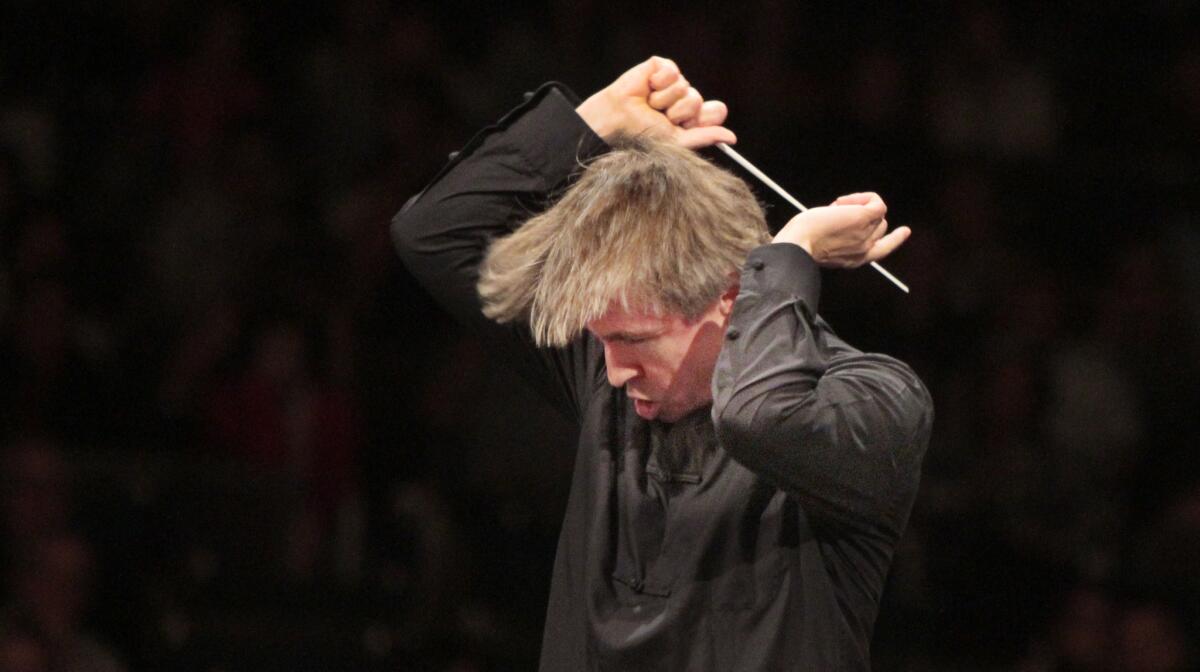Why Salonen’s ‘Universe of Sound: The Planets’ L.A. stop was canceled

- Share via
For more than 30 years, L.A. audiences and arts funders have followed Esa-Pekka Salonen down new pathways into classical music.
But funders and fundraisers stumbled when faced with the former Los Angeles Philharmonic music director’s latest ramble, “Universe of Sound: The Planets,” perhaps the most innovative of all.
A planned late-September presentation of the traveling audio-visual installation had loomed as the biggest classical music event so far in downtown L.A.’s Grand Park, but it has been canceled for lack of money to pull it off.
The Music Center, in charge of park programming, had advertised a Sept. 20-28 run with free admission but quietly canceled it, saying it was unable to raise enough money for the immersive digital display housed in a tent.
Conceived by Salonen for the London-based Philharmonia Orchestra, where he’s principal conductor and artistic advisor, the installation uses digital audio and high-resolution video to simulate what visitors would experience if they found themselves plunked down in the middle of an orchestra performing Gustav Holst’s “The Planets.”
Angelenos would have been the first U.S. audiences to experience it, in a tent pitched on Grand Park’s Event Lawn across Spring Street from City Hall.
The Music Center broke the news somewhat flippantly on the Grand Park website: “the Music Center regrets that this event has been cancelled. Unfortunately, underwriting needed to support the installation did not become available. Awww....”
“We had been gung-ho and talking with a funder,” Music Center spokeswoman Joan Cumming said last week. “Things were moving along really well, but the funder came back and said they had changed their strategy and were going to fund something else.”
The Music Center decided around July 20 that it couldn’t afford to proceed. “We needed to make the decision before the project was packed and shipped to the U.S.,” Cumming said.
“We were really excited,” she added. “It was a perfect blending of classical music and modern technology. Absolutely we love Esa-Pekka and believe in these things.... It’s just a challenging fundraising environment.”
Cumming declined to identify the funder that withdrew support. She and a spokeswoman for the Philharmonia Orchestra declined to divulge costs for mounting “Universe of Sound” in L.A.
The Music Center did not approach the L.A. Phil, which Salonen led from 1992 to 2009, for help such as introductions to donors who had supported the conductor’s projects in the past, Cumming said. “We’re all independent nonprofit organizations, and we all do our own fundraising.”
With the Phil, Salonen brought multimedia elements to orchestral performances in “The Tristan Project” (2004), which involved noted video artist Bill Viola and stage director Peter Sellars. Last year, to celebrate Walt Disney Concert Hall’s 10th anniversary, he performed a staged version, with projections, of Frank Zappa’s orchestral suites from the cult film “200 Motels.”
“Universe of Sound: The Planets” premiered in London in 2012 at the city’s Science Museum, where its launch was part of the cultural festivities surrounding the 2012 London Summer Olympics. (A version of “Universe of Sound” is available on Signum Vision DVD and Blu-ray.) It followed a 2009 companion piece, “Re-Rite,” that offered a similar digital immersion in the orchestra as it performs Stravinsky’s “The Rite of Spring.”
“Re-Rite” had been identified as a special event for August 2013 on the stage of the Dorothy Chandler Pavilion, but it did not take place. It had to be abandoned because its complex requirements couldn’t be met within the limited time the Chandler Pavilion stage was available that summer for Music Center-sponsored presentations, said Cumming.
Although no major performances took place at the venue between a ballet program July 21 and Los Angeles Opera’s fall season opening on Sept. 21, she said that maintenance needs and opera rehearsals limited the available dates for “Re-Rite.”
Talks about bringing in “Universe of Sound” had begun about a year ago, Cumming said, when it became clear the Music Center couldn’t proceed with “Re-Rite.”
A spokeswoman for Salonen said he would not comment because he isn’t involved in touring arrangements for the two installations. Neither has been seen in the United States.
Philharmonia Orchestra spokeswoman Alice Walton said in an email that “while we are of course disappointed that the required funds have not been forthcoming to bring this project to L.A., we support the Music Center’s decision and understand how difficult it must have been to make it.”
Both of the Salonen/Philharmonia installations continue to tour. There have been multiple engagements in the U.K., with more planned, Walton said. Funding there comes from private foundations and trusts, she said, and the government cultural agency, Arts Council England, has made grants to deploy the installations as tools for building interest in classical music among “hard to reach” communities.
“Re-Rite” has gone to Germany, Austria and Turkey, she said, and more than 95,000 people saw it during a three-week stop in Tianjin, China. Further international touring is being scheduled.
“Re-Rite” and “Universe of Sound” both use big, high-resolution screens to simulate what it would be like to walk through each section of an orchestra and experience from point-blank range the focused intensity and physical effort that go into playing classical music.
There’s also a hands-on interactive element that invites viewers to join the performance. One room in the “Universe of Sound” installation has an array of drums, gongs and other percussion instruments; onscreen a Philharmonia percussionist shows how to play parts from “The Planets,” with viewers invited to grab something to bang on and play along.
People who play strings, brass or wind instruments can sit in with those orchestral sections. Visitors also are invited to experience Salonen’s vantage point on the podium, facing the orchestra. Motion-sensing technology combined with patterns traced on a screen allows them to try to emulate the hand movements needed to keep the beat through passages of “The Planets.” Mistakes are audible if they falter.
In a video on the Philharmonia Orchestra website, Salonen said that the installation “gives you a unique perspective on what an orchestra is and what we do.” As for the conducting simulator, he quipped, “You can put yourself into the picture … replacing me. So just make sure you don’t do it too well.”
More to Read
The biggest entertainment stories
Get our big stories about Hollywood, film, television, music, arts, culture and more right in your inbox as soon as they publish.
You may occasionally receive promotional content from the Los Angeles Times.










